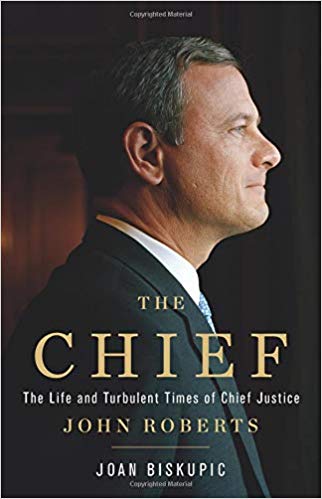Ask the author: Mr. Everything Joan Biskupic on Chief Justice John Roberts


The following is a series of questions posed by Ronald Collins to Joan Biskupic about Biskupics book The Chief: The Life and Turbulent Times of Chief Justice John Roberts (Basic Books, 2019, 432 pp., cloth: $32.00).
Joan Biskupic is a legal analyst at CNN and the author of three previous biographies of Supreme Court justices. She has also served as the Supreme Court correspondent for The Washington Post and USA Today.
Welcome Joan, and thank you for taking the time to participate in this question-and-answer exchange for our readers. And congratulations on the publication of your latest book.
* * *
Nothing that I have witnessed suggests that there will be any lessening of the divisions on the Court this term.
— John Roberts to Henry J. Friendly, Nov. 1, 1980
Question: I want to begin with that excerpt from a letter that the young law clerk to Justice William Rehnquist wrote to his former boss, Judge Henry Friendly. In your opinion, do such divisions continue to plague the court nearly four decades after that letter was written? If so, how do you think Roberts will manage them in what you term turbulent times?
Biskupic: Thank you, Ron, for these questions about The Chief. And, yes, it was ever thus. Such divisions reflect the nature of political appointments to Americas highest court. But our times are even more politicized. So, the challenge for Roberts today is greater than it was in his earlier years. He has shown a pattern of trying to compromise a bit with alternate sides, as happened in his Affordable Care Act moves. Weve seen that in a sequence of orders this term, e.g., in the Louisiana abortion case and the Alabama Muslim death penalty dispute of early February.
Question: Youve known John Roberts for over two decades, having covered him throughout his career as a Justice Department lawyer, an appellate court advocate and a court of appeals judge. And yet, you describe him as an enigma. You draw upon something suggested by David Leebron, one of Roberts Harvard Law Review colleagues: Roberts is an introvert who has learned to act as an extrovert.
Can you give us a rough sketch of the man whom Kenneth Starr tagged Mr. Everything?
Biskupic: Yes, terrifically smart and determined but with a personal reserve, shyness even. I liked Leebrons description and was pleased to draw that out of him. The Mr. Everything line from Ken Starr regards John Roberts youth at La Lumiere School. He was a star student who participated in all manner of extracurriculars. I often asked people who knew Roberts in his younger years about setbacks he might have experienced. That question stumped people. He seemed to have so few things go wrong, and he appeared good at just about everything.
Question: You describe the chief justice as strategizing more than sublimating, always with an eye toward what he wants in the ultimate ruling and how it will appear. Can you give us an example?
Biskupic: I think we see elements of that in his concurring statements in Citizens United v. Federal Election Commission and in Schuette v. Coalition to Defend Affirmative Action, in which he tries to influence how the majority opinion will be regarded and to uncut the dissenting arguments. Roberts rarely writes concurrences; when he does, its revealing.
Question: How does Roberts differ from the jurists for whom he once clerked, Friendly and Rehnquist?
Biskupic: He is not as moderate on the law as Friendly. He is not as easygoing with his colleagues as Rehnquist. When Rehnquist became chief in 1986, he already had had 14 years on the bench. He had built up relations of trust. Roberts, far younger and with less experience than his colleagues, had to start from scratch to build relationships.
Question: Do you think the chief justice is more judicially temperate than the other Republican appointees on the Supreme Court bench — Justices Clarence Thomas, Samuel Alito, Neil Gorsuch and Brett Kavanaugh?
Biskupic: Yes, and I think thats partly because he is chief justice. Roberts has acknowledged that he takes a different approach to cases as chief than he would as an associate justice.
Question: Regarding Roberts opinion in National Federation of Independent Business v. Sebelius (2012), in which the court upheld the Affordable Care Acts individual mandate to buy health insurance, you write: Viewed only through a judicial lens, his moves were not consistent and his legal arguments were not entirely coherent. But he brought people and their different interests together. He acted, in short, more like a politician.
Is that ever likely to happen again? And how does this square with the chief justices concern for protecting the institution of the court?
Biskupic: His actions arose from many motives, including an effort to protect the Supreme Court as an institution. He wanted to avoid a 5-4 decision along predictable political lines in a presidential election year. Is that likely to happen again? Probably, but perhaps in a less sensational case. So much was happening in the dispute centered on the long-intractable healthcare problem and the signature domestic achievement of President Barack Obama.
Question: Last February, while speaking at Belmont Law School, Roberts declared: Im probably the most aggressive defender of the First Amendment. Most people might think that doesnt quite fit with my jurisprudence in other areas… People need to know that were not doing politics. Were doing something different. Were applying the law.
You devote a thoughtful chapter to the chief justices free speech jurisprudence. What do you make of his Belmont remarks and their implications for the future course of free speech law in the Supreme Court? Do you view his jurisprudence in this area as, in Justice Elena Kagans words, weaponizing the First Amendment?
Biskupic: That Belmont remark jumped out at me, too, Ron. First Amendment issues often do not break in the usual ideological patterns. But I think that Citizens United and the Janus v. AFSCME case that drew Kagans weaponizing rebuke had overriding political dimensions and divided the Republican and Democratic appointees precisely along political lines. I also do not believe Kagan is less committed to the First Amendment in the traditional sense, even though she was on the opposite side in Janus.
Question: During oral argument in Obergefell v. Hodges (2015), Roberts took exception to the claim of the petitioners attorney that her clients were only asking the court to allow a class of people who are, by state laws, excluded from being able to participate in this institution. The chief saw the matter through a different lens: No … youre not seeking to join the institution, youre seeking to change what the institution is. The fundamental core of the institution is the opposite-sex relationship and you want to introduce into it a same-sex relationship.
Given that, and given the chief justices dissent in Obergefell, how likely do you think it is that he will adhere to that precedent, especially in cases involving countervailing claims of religious conscience?
Biskupic: I think his dissent in Obergefell, particularly that he voiced it from the bench (first and only time ever for such an oral dissent) reveals Roberts deeply held views in this area. I cannot see him voting to overrule Obergefell but he could diminish the reach of its protections. We saw that in the Masterpiece Cakeshop v. Colorado Civil Rights Commission decision last term. In a similar vein, I think Roberts would be inclined against extending Title VII to cover sexual orientation and gender identity. The court has so far this term deliberately avoided the issue.
Question: In Dickerson v. United States (2000), Rehnquist declined to expressly overrule Miranda v. Arizona (1966), despite a forceful dissent by Justice Antonin Scalia joined by Justice Clarence Thomas. In his majority opinion, Rehnquist declared: We do not think there is [sufficient] justification for overruling Miranda. Miranda has become embedded in routine police practice to the point where the warnings have become part of our national culture. … While we have overruled our precedents when subsequent cases have undermined their doctrinal underpinnings, … we do not believe that this has happened to the Miranda decision. If anything, our subsequent cases have reduced the impact of the Miranda rule on legitimate law enforcement while reaffirming the decision’s core ruling that unwarned statements may not be used as evidence in the prosecution’s case in chief.
Do you think Roberts would follow the jurisprudential path paved by Rehnquist in Dickerson when it comes to Roe v. Wade (1973)?
Biskupic: I think Roberts would offer something less than the endorsement Rehnquist gave Miranda. The chief might come as close to overruling Roe as possible without explicitly overruling it.
Question: As you point out, Roberts has long been concerned about racial balancing. In his majority opinion in Parents Involved in Community Schools v. Seattle School District No. 1 (2007), he wrote: The principle that racial balancing is not permitted is one of substance, not semantics. Racial balancing is not transformed from patently unconstitutional to a compelling state interest simply by relabeling it racial diversity.
Currently, there are several affirmative action cases in the lower courts, including Students for Fair Admissions v. President and Fellows of Harvard College. Among other things, that case raises the question of whether the court should overrule its precedents and hold that Title VI forbids any consideration of race by a federally funded university.
How do you think the chief justice would approach this issue?
Biskupic: I covered that Harvard trial in Boston, and I am sure the chief and other justices know that issue is slowly moving toward them. I believe Roberts would rule that Title VI indeed forbids any racial considerations in education. This is one area in which Roberts has been consistent since his time in the Reagan years. He abhors race-based policies, saying they do more harm than good.
Question: As you know, administrative law and the power allotted to federal agencies is an immensely important, though not sexy, topic. Kavanaugh has advanced some noteworthy arguments concerning statutory interpretation and administrative law. Specifically, he objects on separation-of-powers grounds to the growth of the administrative state, which he calledthe headless fourth branch of the government.
If an appropriate case came before the court, would the chief justice embrace Kavanaughs view?
Biskupic: We just had oral argument on this topic, and I sensed some resistance on Roberts part, perhaps because of how strongly Justice Stephen Breyer and Kagan framed the issue of precedence. How much does the chief justice want to roll back the law in the volatile Trump era? Im inclined to think Roberts would wait to reverse Auer v. Robbins, etc.
Question: Should the court ever be reconstituted with a 6-3 conservative-liberal split, do you think that would affect Roberts ability to influence the direction of the law?
Biskupic: Yes, it would change his current position at the exact ideological center of the bench and put him strange to say more on the left. But even as I witnessed his often-failed efforts to woo Justice Anthony Kennedy and now watch his struggles to steady the court, I would never underestimate his ability to influence people. In fact, the chief justice may already be thinking ahead to that very 6-3 possibility. You quoted Ken Starr earlier. Ill close with another former colleague of Roberts from the Reagan era: John Roberts has always seen everything with pristine clarity, and almost instantly, Mike Luttig told me.
Thank you, Ron, for your thoughtful questions.
Posted in Book reviews/Ask the author

